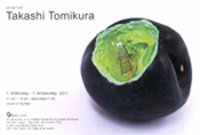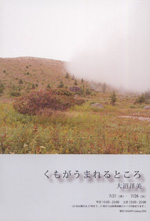 |
Picks is a monthly sampling of Japan's art scene, offering short reviews of exhibitions at museums and galleries in recent weeks, with an emphasis on contemporary art by young artists. |
 |
 |
 |
1 September 2011 |
 |
| 1 | 2 | |
 |
|
 |
 |
|
|
 |
 |
 |
 |
| Daido Moriyama: On the Road |
| 28 June - 19 September 2011 |
The National Museum of Art, Osaka
(Osaka) |
 |
| This retrospective has two parts: a close-up look at Moriyama's work today and a chronological tracing of the evolution of his style over the decades. Together they provide a well-rounded sense of his unique viewpoint and language as a photographer who works "on the road." Every detail of these compositions writhes, quivers, and quakes with a powerful, ever-vibrating life force. |
|
 |
|

|
 |
 |
|
|
|
|
|
 |
 |
 |
|
|
Takashi Tomikura
|
|
18 - 30 July 2011
|
O Gallery eyes
(Osaka) |
 |
| His inspiration for the work in this show, Tomikura says, is his childhood memory of lifting up flowerpots to find wiggly creatures dwelling underneath. These paintings and objects all depict a borderland rarely exposed to the human eye and hence all the more surprising when we do catch a glimpse of it. They also evoke boundaries in time, like the dreamlike state between sleeping and waking. |
|
|
|
|
|
|
 |
 |
|
|
Dojima River Biennale 2011 -- Ecosophia: Art and Architecture
|
|
23 July - 21 August 2011
|
Dojima River Forum
(Osaka) |
 |
| This, the second Dojima Biennale, was directed by Aomori Museum of Art curator Takayo Iida, who clearly had on her mind the disaster that recently befell her home region of Tohoku. With works by 16 artists and art units in a venue divided into "realms" of earth, water, and air under the theme of ecosophy (a neologism from ecology and philosophy), the show presented artistic and architectural visions of the earth from the perspectives of the natural, social, and psychological environments. That's a lot to chew on, but the dark interior proved to be an optimum environment in which to digest each exhibit in full. |
|
 |
 |
 |
|
| Hiromi Onuma: Where Clouds Are Born |
| 21 - 26 July 2011 |
Gendai Heights Gallery Den
(Tokyo) |
 |
| A graduate of the Tohoku University of Art & Design in her native Yamagata, photographer Onuma has pursued her career close to home. These portrayals of smoke, fog and mist in mountain settings do indeed capture the places and moments "where clouds are born." Onuma's meticulous attention to the interplay of air currents and landscapes is matched by a well-executed installation that places ground-level shots close to the gallery floor and images of mountaintops up high on the wall. |
|
|
|
|
 |
|
|
 |
|